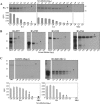Search for Bacillus anthracis potential vaccine candidates by a functional genomic-serologic screen
- PMID: 16790772
- PMCID: PMC1489694
- DOI: 10.1128/IAI.00174-06
Search for Bacillus anthracis potential vaccine candidates by a functional genomic-serologic screen
Abstract
Bacillus anthracis proteins that possess antigenic properties and are able to evoke an immune response were identified by a reductive genomic-serologic screen of a set of in silico-preselected open reading frames (ORFs). The screen included in vitro expression of the selected ORFs by coupled transcription and translation of linear PCR-generated DNA fragments, followed by immunoprecipitation with antisera from B. anthracis-infected animals. Of the 197 selected ORFs, 161 were chromosomal and 36 were on plasmids pXO1 and pXO2, and 138 of the 197 ORFs had putative functional annotations (known ORFs) and 59 had no assigned functions (unknown ORFs). A total of 129 of the known ORFs (93%) could be expressed, whereas only 38 (64%) of the unknown ORFs were successfully expressed. All 167 expressed polypeptides were subjected to immunoprecipitation with the anti-B. anthracis antisera, which revealed 52 seroreactive immunogens, only 1 of which was encoded by an unknown ORF. The high percentage of seroreactive ORFs among the functionally annotated ORFs (37%; 51/129) attests to the predictive value of the bioinformatic strategy used for vaccine candidate selection. Furthermore, the experimental findings suggest that surface-anchored proteins and adhesins or transporters, such as cell wall hydrolases, proteins involved in iron acquisition, and amino acid and oligopeptide transporters, have great potential to be immunogenic. Most of the seroreactive ORFs that were tested as DNA vaccines indeed appeared to induce a humoral response in mice. We list more than 30 novel B. anthracis immunoreactive virulence-related proteins which could be useful in diagnosis, pathogenesis studies, and future anthrax vaccine development.
Figures



Similar articles
-
In vitro screen of bioinformatically selected Bacillus anthracis vaccine candidates by coupled transcription, translation, and immunoprecipitation analysis.Methods Mol Biol. 2007;375:211-33. doi: 10.1007/978-1-59745-388-2_11. Methods Mol Biol. 2007. PMID: 17634604 Review.
-
Search for potential vaccine candidate open reading frames in the Bacillus anthracis virulence plasmid pXO1: in silico and in vitro screening.Infect Immun. 2002 Dec;70(12):6817-27. doi: 10.1128/IAI.70.12.6817-6827.2002. Infect Immun. 2002. PMID: 12438358 Free PMC article.
-
Genome-based bioinformatic selection of chromosomal Bacillus anthracis putative vaccine candidates coupled with proteomic identification of surface-associated antigens.Infect Immun. 2003 Aug;71(8):4563-79. doi: 10.1128/IAI.71.8.4563-4579.2003. Infect Immun. 2003. PMID: 12874336 Free PMC article.
-
A novel live attenuated anthrax spore vaccine based on an acapsular Bacillus anthracis Sterne strain with mutations in the htrA, lef and cya genes.Vaccine. 2017 Oct 20;35(44):6030-6040. doi: 10.1016/j.vaccine.2017.03.033. Epub 2017 Mar 23. Vaccine. 2017. PMID: 28342664
-
Progress and novel strategies in vaccine development and treatment of anthrax.Immunol Rev. 2011 Jan;239(1):221-36. doi: 10.1111/j.1600-065X.2010.00969.x. Immunol Rev. 2011. PMID: 21198675 Review.
Cited by
-
An update on the transport and metabolism of iron in Listeria monocytogenes: the role of proteins involved in pathogenicity.Biometals. 2015 Aug;28(4):587-603. doi: 10.1007/s10534-015-9849-5. Epub 2015 Mar 28. Biometals. 2015. PMID: 25820385 Free PMC article. Review.
-
Development of ELISA based on Bacillus anthracis capsule biosynthesis protein CapA for naturally acquired antibodies against anthrax.PLoS One. 2021 Oct 11;16(10):e0258317. doi: 10.1371/journal.pone.0258317. eCollection 2021. PLoS One. 2021. PMID: 34634075 Free PMC article.
-
Immunospecific responses to bacterial elongation factor Tu during Burkholderia infection and immunization.PLoS One. 2010 Dec 17;5(12):e14361. doi: 10.1371/journal.pone.0014361. PLoS One. 2010. PMID: 21179405 Free PMC article.
-
Genetic analysis of petrobactin transport in Bacillus anthracis.Mol Microbiol. 2010 Feb;75(4):900-9. doi: 10.1111/j.1365-2958.2009.07025.x. Epub 2010 Jan 13. Mol Microbiol. 2010. PMID: 20487286 Free PMC article.
-
Mining the Moraxella catarrhalis genome: identification of potential vaccine antigens expressed during human infection.Infect Immun. 2008 Apr;76(4):1599-607. doi: 10.1128/IAI.01253-07. Epub 2008 Jan 28. Infect Immun. 2008. PMID: 18227159 Free PMC article.
References
-
- Adu-Bobie, J., B. Capecchi, D. Serruto, R. Rappuoli, and M. Pizza. 2003. Two years into reverse vaccinology. Vaccine 21:605-610. - PubMed
Publication types
MeSH terms
Substances
LinkOut - more resources
Full Text Sources
Other Literature Sources
Medical

